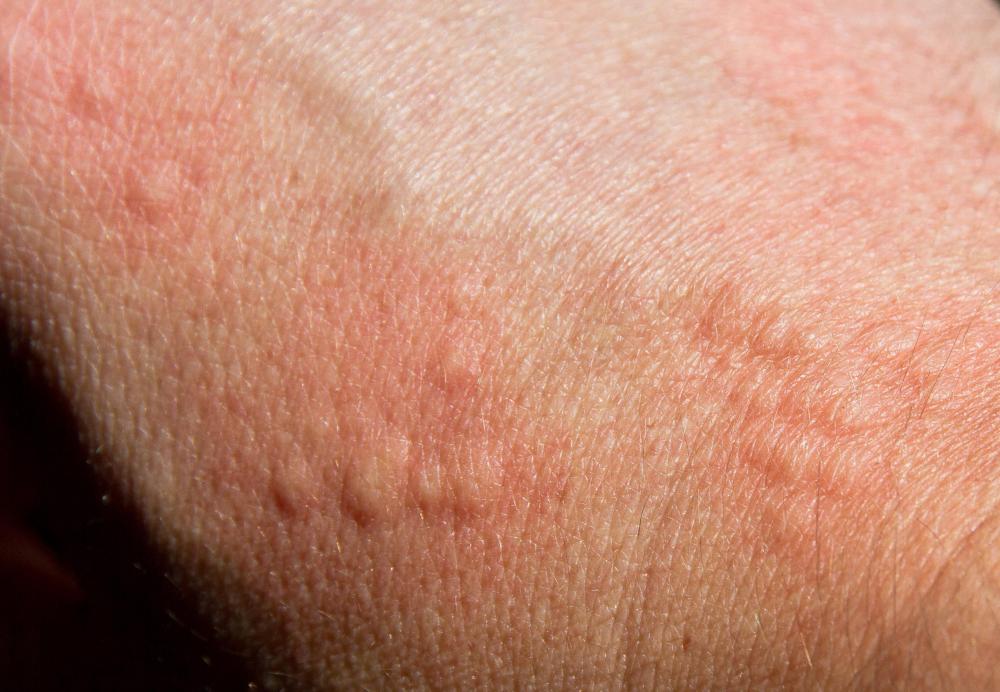At WiseGEEK, we're committed to delivering accurate, trustworthy information. Our expert-authored content is rigorously fact-checked and sourced from credible authorities. Discover how we uphold the highest standards in providing you with reliable knowledge.
What is a Wheat Allergy?
A wheat allergy is a type of food allergy characterized by adverse reactions to the consumption of wheat. In addition to causing problems when wheat is eaten, wheat allergies may also result in skin reactions in response to contact with wheat, and in respiratory problems after inhaling wheat pollen and wheat dust. Along with soy, dairy, egg, shellfish, tree nut, peanut, and fish allergies, wheat allergies are very widespread around the world, with people from a wide variety of backgrounds experiencing wheat allergies and sensitivity to wheat.
Like other allergies, a wheat allergy is caused by a reaction between the body's immune system and the proteins present in the wheat. In order for a wheat allergy to develop, someone needs to eat wheat at least once, so that the immune system is exposed to the protein. Once exposed, the immune system learns to identify the proteins, and when these proteins are introduced to the body again, the body is flooded with histamines to attack the proteins, thereby triggering an allergic reaction.

Food allergies seem to be more common when people are exposed to potential allergens while under the age of three, with some parents specifically avoiding potential allergens in food intended for young children for this reason. Parents should consult their doctors about the diet most appropriate for their children.
When someone with a wheat allergy consumes wheat, he or she may experience symptoms like airway restriction, gastrointestinal distress, hives around the mouth, and inflammation in the mouth. Some people also develop hives on other parts of the body, and in extreme cases, anaphylaxis may occur. Wheat allergies can also cause contact dermatitis and airway issues when people are exposed to wheat, wheat pollen, chaff, and other wheat products, as for instance when a home is swept with a wheatstraw broom.

It is important to distinguish a wheat allergy from gluten intolerance. Gluten intolerance is caused by an inability to process gluten, a protein which is present in wheat, and it is often congenital, although it can be acquired. In addition to being present in wheat, gluten can be found in many other grains as well.
If an allergic reaction is experienced after eating, it is important to seek the advice of a doctor, to handle the symptoms of the reaction and to explore the causes. Allergy testing may be required to determine what the patient reacted to, so that it can be avoided in the future. While a doctor may assume that the reaction is caused by wheat consumption, it is a good idea to ask for testing to ensure that the allergen isn't more obscure. Once wheat is identified as the culprit, the patient can avoid exposure to wheat in the future.
AS FEATURED ON:
AS FEATURED ON:














Discussion Comments
Well wheat isn't something the human body should be digesting. It takes a cow three stomachs to digest grass and wheat is a grass.
My friend began eliminating wheat from his diet because he was having a lot of digestion problems, and his chiropractor recommended he try a wheat free diet program.
In the process, he lost 17 pounds and felt better than he had in years. Many of his digestion problems also went away. I read in a gluten free cookbook that most people who have Celiac disease, which is a sensitivity to gluten, are never diagnosed with it.
If you start to read labels, you will realize that wheat is in just about everything! It can be a real challenge to follow a wheat free diet, but it is easier than it used to be.
It is much easier to find foods that are gluten free, but when you eat out you must be very careful and ask questions if you need to. There are some foods that you know are safe, such as a salad, but then you must determine if the dressing has any type of wheat product in it, or make sure they don't put any croutons on top of your salad.
It takes constant monitoring, but many people who have had wheat allergies for years begin to feel so much better when they begin eliminating wheat from their diet.
Post your comments